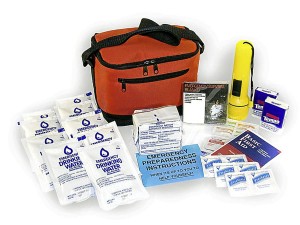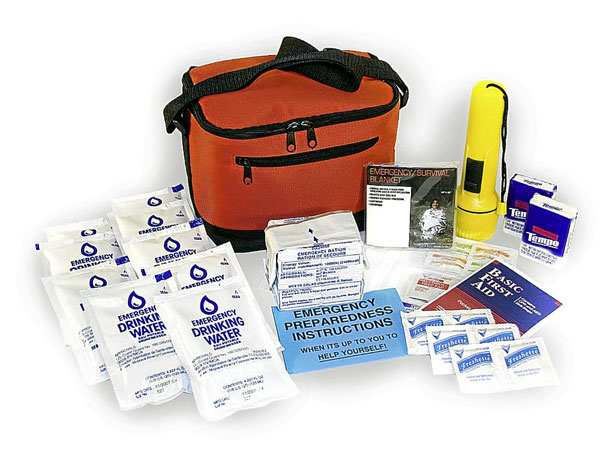
Take Bear Grylls’ advice: Wherever you are staying – in the house, your work station or inside your car – you need a “Go Bag” kept close at hand at all times.
The daredevil host of Discovery Channel’s “Man vs. Wild” constantly reminds viewers to have a back up plan and to always think of the worst case scenario.
And what better way to be prepared than to have a Go Bag that you can just grab should an emergency occur.
Since you cannot foresee where you may be when disaster strikes, experts recommend that you prepare separate Go Bags for your home, office and vehicle.
A Go Bag is any bag, preferably a back pack, that contains supplies as well as tools that will not only increase your comfort, safety, and chances of survival but make you self-sufficient for at least three days (say, you are trapped inside a room or isolated in a building basement). Remember to keep the Go Bag as compact and as light as possible.
Just what should go into a Go Bag?
Water. No Go Bag is complete without drinking water – at least 4 liters – placed in a handy container that can easily be opened and is convenient to use.
If you choose to use bottled water, always check the manufacturer’s expiry date and make sure to replace them to make sure they are always safe to drink.
Nuts, seeds, dried fruits or vegetables. Stock up on nuts, seeds and dried fruits, such as pineapples and raisins, as these high-energy foods are convenient and have a long shelf life.
Dried fruits also offer potassium, dietary fiber and a significant amount of nutrients and calories.
Look for vacuum-packed as well as re-sealable containers, as these will prevent the items inside from oxidizing and losing their freshness.
Energy or chocolate bars. Another good source of nutrients in case you can’t venture out or are trapped for several days are granola bars, fruit bars, high-energy protein bars, salted crackers, as well as chocolate bars.
Just make sure they are encased in an air- and water-tight container so ants and other small animals won’t feast on them.
Canned goods. Make sure to include six canned goods with lids that can easily be opened. An excellent example is this tuna paella packed in a can that requires no can opener. It can be considered a complete meal as it contains rice mixed with tuna and some green peas.
Vitamins. In a tight fix? Keeping multivitamins will certainly help replace the nutrients you would have consumed on a normal diet.
First aid kit. After water and food, you need to prepare a first aid kit that contains at least a couple of pain relievers, bandages (could also be used for tying or securing things), gauze, eye drops, wet wipes, an antibiotic ointment and burn cream.
If you have to take medication, make sure you include it in your first aid kit. Considering that medicines can expire, make sure to check them regularly and replace with fresh ones if necessary.
Swiss knife. If there is one indispensable item you never leave home without, it should probably be the Swiss Army or any type of pocket knife that can be used for cutting, scraping and puncturing.
If you have three Go Bags, make sure each one has this very handy item.
Flash light. Next to a pocket knife, a flash light, preferably an LED type, is one thing you should never go without.
Don’t skimp on quality when it comes to an LED flashlight: The cheap plastic ones are not what you can rely on when it counts. Make sure to find one that’s long lasting.
Lighter or matches. Together with a flashlight, make sure to include a lighter or a box of matches.
Whistle. Should come in handy if you are too hoarse or too tired to shout for help. Since a whistle is too small, attach it on a necklace cord.
Pen and small notebook. They may not appear that important but a pen and a piece of paper may help in recording things or just keeping you sane as you wait for outside help.
Cash. Cash in small denominations of at least P300 stored in your Go Bag should go a long way. If you are stranded or have to walk and you need something to eat and drink, you have the means to buy it.
Portable radio. You only need a small one powered by small batteries. Always keep spare batteries as back up.
Rope. Just in case you need to climb down a collapsed structure, keep a climbing rope of at least 5 meters handy.
Go Bag for Cars. A Go Bag for cars should be no different from what you have for your home or office.
However, it should contain a roll of duct tape. You’d be surprised how many times a single roll of duct tape can save you. Duct tape can temporarily fix a broken windshield wiper, hold glass together, pick up glass shards, serve as a temporary gas cover, mend a broken hose and has a thousand other uses.
Another important item to include in your car Go Bag is a blanket that can ward off cold or hypothermia. You can also use blankets for a variety of important tasks in an emergency, such as smothering flames, covering wounds or fashioning tourniquets.
Where to place the Go Bag? The most obvious place would be in the trunk, but what if you can’t get out? The next best place is under the driver’s or front passenger’s seat since it is easily accessible.
Remember the “Rule of Threes.” You can live three minutes without AIR, three hours without SHELTER in a bad environment, three days without WATER and three weeks without FOOD. In a survival situation, this is a good guide to think about.
Indeed, survival is not just a matter of luck. We can do far more to improve our odds of surviving even under the most horrendous of circumstances. It’s all a matter of preparation.












































